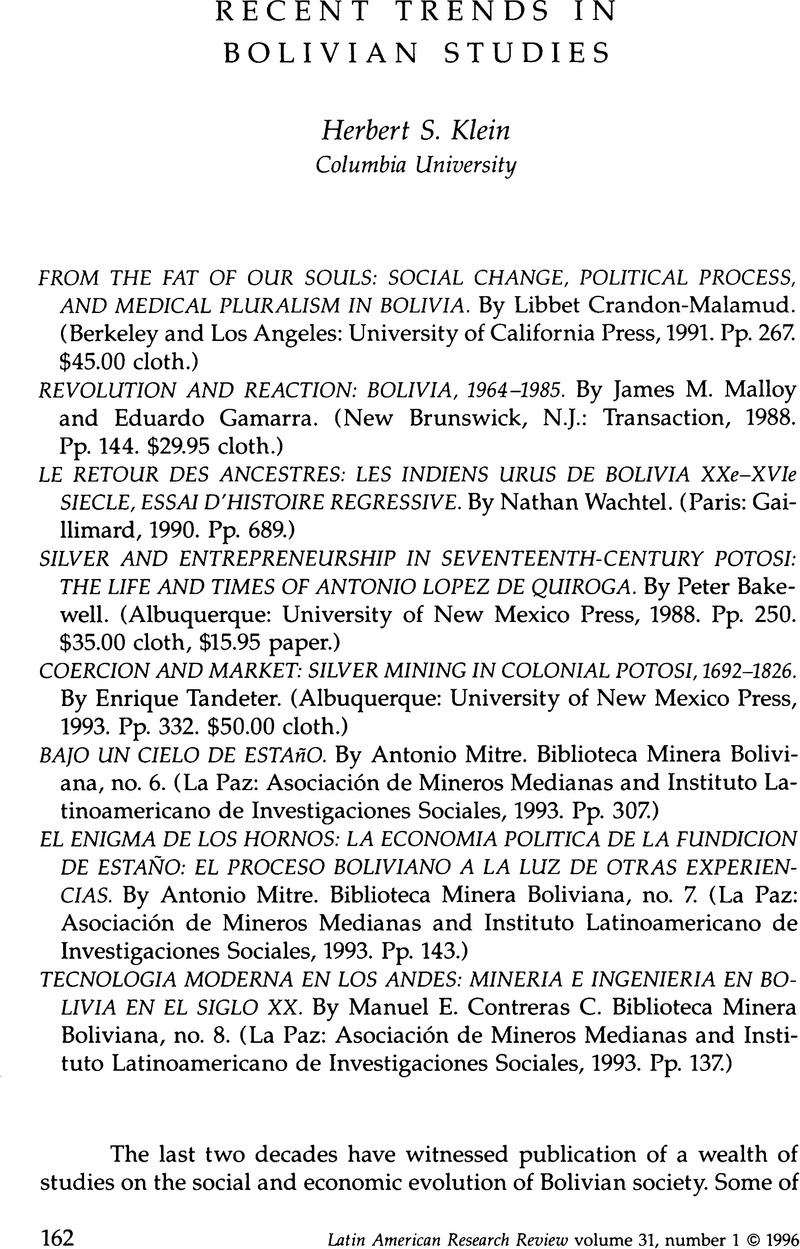No CrossRef data available.
Published online by Cambridge University Press: 05 October 2022

1. See Brooke Larson, “Bolivia Revisited: New Directions in North American Research in History and Anthropology,” LARR 23, no. 1 (1988):63–90.
2. Erick D. Langer, Economic Change and Rural Resistance in Southern Bolivia, 1880–1930 (Stanford, Calif.: Stanford University Press, 1989); Ricardo A. Godoy, Mining and Agriculture in Highland Bolivia: Ecology, History, and Commerce among the Jukumanis (Tucson: University of Arizona Press, 1990); Lesley Gill, Peasants, Entrepreneurs, and Social Change: Frontier Development in Lowland Bolivia (Boulder, Colo.: Westview, 1987); and Brooke Larson, Colonialism and Agrarian Transformation in Bolivia, 1550–1900 (Princeton, N.J.: Princeton University Press, 1988).
3. Herbert S. Klein, Haciendas and Ayllus: Rural Society in the Bolivian Andes in the Eighteenth and Nineteenth Centuries (Stanford, Calif.: Stanford University Press, 1993).
4. Peter Bakewell, Miners of the Red Mountain: Indian Labor in Potosí, 1545–1650 (Albuquerque: University of New Mexico Press, 1984). For a detailed review of this work, see my appraisal in New Mexico Historical Review 60, no. 4 (1985):451–52.
5. Jeffrey Cole, The Potosí Mita, 1573–1700: Compulsory Indian Labor in the Andes (Stanford, Calif.: Stanford University Press, 1985). For a more detailed analysis of this work, see my review in Labor History 27, no. 3 (Summer 1986):470–72.
6. Rose Marie Buechler, Gobierno, minería y sociedad: Potosí y el “renacimento” borbónico, 1776–1810, 2 vols., Biblioteca Minera Boliviana, no. 5 (La Paz: Asociación Nacional de Mineros Medianos, 1989). An English edition has also been published under the title The Mining Society of Potosí, 1776–1810 (Ann Arbor: University Microfilms for the Department of Geography, Syracuse University, 1981).
7. Antonio Mitre, Los patriarcas de la plata (Lima: Instituto de Estudios Andinos, 1981).
8. Walter Gómez, La minería en el desarrollo económico de Bolivia (La Paz: Los Amigos del Libro, 1978).
9. For example, see Thierry Saignes, Los andes orientales: Historia de un olvido (La Paz: CERES-IFEA, 1985).
10. Clara López Beltrán's recent thesis provides an interesting beginning for analyzing the mechanism of elite maintenance and control in this crucial Bolivian urban center. See “The Vecinos of the City of La Paz in Charcas: A Study of an Urban Elite, 1645–1680,” Ph.D diss., Columbia University, 1995.
11. Some initial studies in this area show the extraordinary richness of the archival materials. See, for examples, the works of Bolivian scholars: Laura Escobari de Querejazu, Producción y comercio en el espacio sur andino, siglo XVII: Cusco-Potosí, 1650–1700 (La Paz: Embajada de España, 1985); and Mary Money, Los obrajes, el traje y el comercio de ropa en la Audiencia de Charcas (La Paz: Embajada de España, 1983). See also studies of urban history by Rossana Barragán, Espacio urbano y dinámica étnica: La Paz en el siglo XIX (La Paz: Hisbol, 1990); and Alberto Crespo, Mariano Baptista Gumucio, and José de Mesa, La ciudad de La Paz: Su historia, su cultura (La Paz: Alcaldía Municipal, 1989). An initial analysis of the evolution of regional markets and political systems is made in Gustavo Rodríguez Ostria, Poder central y proyecto regional: Cochabamba y Santa Cruz en los siglos XIX y XX (La Paz: Instituto Latinoamericano de Investigaciones Sociales and Instituto para el Desarrollo Alternativo Económico y Social, 1993). Also, see two interesting recent books on state finances: Thomas Millington, Debt Politics after Independence: The Funding Conflict in Bolivia (Gainesville: University Press of Florida, 1992); and Carmenza Gallo, Taxes and State Power: Political Instability in Bolivia, 1900–1950 (Philadelphia, Pa.: Temple University Press, 1991).
12. James Dunkerley, Rebellion in the Veins: Political Struggle in Bolivia, 1952–1982 (London: Verso, 1982). See also my review of this work in the American Historical Review 91, no. 4 (Oct. 1986):1027–28.
13. One of the best of the numerous well-developed studies of national health and poverty is Rolando Morales Anaya, Desarrollo y pobreza en Bolivia: Análisis de la situación del niño y la mujer (La Paz: UNICEF, 1984). On urban migration, see Xavier Albó, Godofredo Sandoval, and Tomás Greaves, Chukiyawy: La cara aymara de La Paz, 4 vols. (La Paz: Centro de Investigaciones y Promoción del Campesinado, 1981–1987). On violence, see Violencias encubiertas en Bolivia, edited by Xavier Albó and Raúl Barros, 2 vols. (La Paz: CIPCA Centro de Investigaciones y Promoción del Campesinado-Aruwiyiri, 1993).
14. For example, see Silvia Rivera, Oprimidos pero no vencidos: Luchas del campesinado aymara y qhechwa de Bolivia, 1900–1980 (La Paz: Hisbol, 1986). Much ephemeral literature exists on politics, but few long-term systematic studies have been undertaken. A suggestive recent work that brings together numerous of the author's disparate essays is Jorge Lazarete R., Bolivia: Certezas e incertidumbres de la democracia, 3 vols. (La Paz: Instituto Latinoamericano de Investigaciones Sociales and Los Amigos del Libro, 1993). A first attempt at analyzing recent voting behavior is Salvador Romero Ballivián's Geografia electoral de Bolivia: Así votan los bolivianos (La Paz: Instituto Latinoamericano de Investigaciones Sociales and Centro Boliviano de Estudios Multidisciplinarios, 1993).